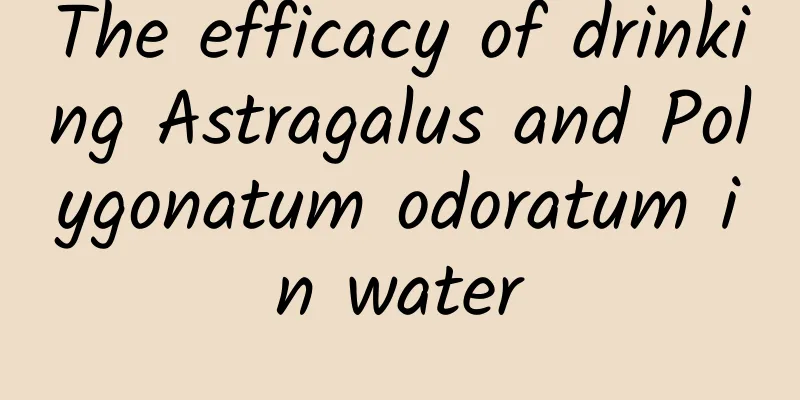The efficacy and function of the root of hairy mulberry

|
There are many common Chinese medicinal materials in life, and Mao Nian root is one of them. However, many people are not very clear about Mao Nian root. Therefore, before choosing to eat it, you need to understand the effects and functions of Mao Nian root. [Source] Medicinal material source: The root of the plant Rhizoma Coptidis of the Melastomataceae family. [Original form] A large hairy shrub, 1.5-3m tall. The above-ground part is covered with long, coarse, flat hairs with swollen bases. Leaves are opposite; petiole is 1.5-4cm long; leaf blade is firm and papery, ovate-lanceolate to lanceolate, 8-22cm long, 2.5-8cm wide, apex is long acuminate or acuminate, base is obtuse or rounded, margin is entire, both sides are covered with strigosus hidden under the epidermis; there are 5 basal veins. Usually there is one flower at the terminal end, sometimes 3-5 flowers form an inflorescence; bracts are halberd-shaped and membranous; pedicels are about 5mm long; calyx tube is 1-2cm long, with 5(-7) lobes, triangular to triangular-lanceolate, with small lobes between lobes; petals are pink or purple-red, 5(-7) in number, broadly obovate, slightly oblique at the upper part, slightly concave at the apex, 3-5cm long, 2-2.2cm wide; 5 stamens are long and 5 are short, the longer ones have extended base of connective and 2 lobes at the end, anthers are about 1.3cm long, the shorter ones have no extended connective, anthers are up to 9mm long, with 2 tubercles at the base; ovary is semi-inferior, 5-chambered, densely covered with bristles. The capsule is cup-shaped and spherical, with a fleshy placenta, which is covered by a persistent calyx. The persistent calyx is densely covered with long red stiff hairs, 1.5-2.2 cm long and 1.5-2 cm in diameter. The flowering and fruiting period is almost all year round, usually from August to October. [Habitat distribution] Ecological environment: Grown at the foot of mountains below 400m above sea level, on the edge of ditches, in moist grass or low bushes. 【Nature and flavor】 Slightly bitter; astringent; neutral 【Functions and indications】 Helps digestion and stops diarrhea; reduces swelling and stops bleeding. It is used for watery diarrhea, dysentery, rheumatic pain, blood in stool, hemoptysis, metrorrhagia, swelling and pain from falls, bleeding from trauma, and snake bites. [Usage and Dosage] For oral use: decoction, 15-30g. For external use: take appropriate amount, decoct in water for washing or grind into powder for application. 【Excerpt】 Chinese Materia Medica The medicinal value of the root of Rhizoma Coptidis introduced in the article is of great help to our lives. In fact, many physical illnesses can be treated with some Chinese medicinal materials such as Mao Nan root. The profound Chinese medicine culture should continue to be passed on. |
<<: The efficacy and function of hairy stem Malan
>>: The efficacy and function of eggplant
Recommend
The efficacy and function of Yingshi
As we all know, Yingshi is a very common medicina...
The efficacy and function of Drynaria fortunei
Traditional Chinese medicine culture is profound ...
The "New Year's Battle Robe" horse-faced skirt actually originated from a donkey-riding woman in the Song Dynasty?
Why did the horse-faced skirt become the "Ne...
The efficacy and function of heart-protecting grass
Traditional Chinese medicine has always been the ...
How to master the correct butt wiping posture?
"Your ass isn't clean!!" From the a...
Watermelons wrapped in plastic wrap have too many bacteria, which can cause poisoning? Remember these 4 points to eat watermelons safely!
Author: Zhang Yu, researcher at the Chinese Cente...
The role and efficacy of Chuanxiong
Medicine is a very good choice for treating disea...
Effects and functions of small fruit golden flower tea
The development of Western medicine has brought s...
What are the contraindications of Cistanche deserticola?
I believe that many young people today know about...
Why is there a saying that "cold urine and hot farts"? A little physiological secret from the perspective of biomechanics
1. Introduction "Cold urine, hot farts, poor...
Is calcium supplementation useful for the elderly and children? Do young people need calcium supplementation?
Is it necessary for young people aged 20-30 to su...
The role of Chinese herbal medicine Angelica dahurica
The world is full of wonders. There are many thin...
The efficacy and function of Aowawei
Avowa is a common Chinese medicine. It can be use...
What are the medicinal values of corrugated paper?
Nowadays, my country uses both traditional Chines...
The mystery of the moon's "exodus": it is moving away from the Earth at a speed of 3.8 cm per year
From the total solar eclipse On May 28, 585 BC, s...









